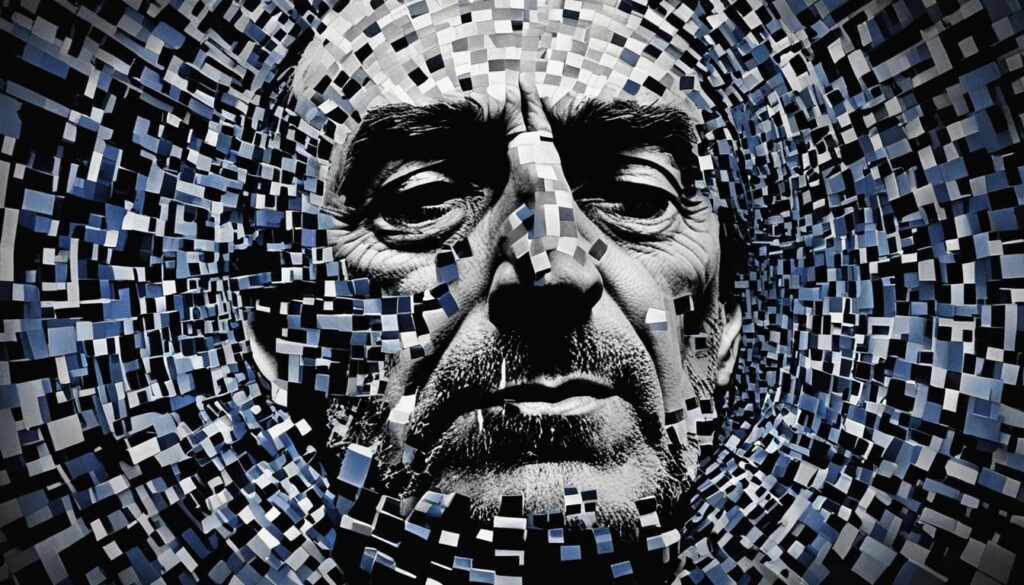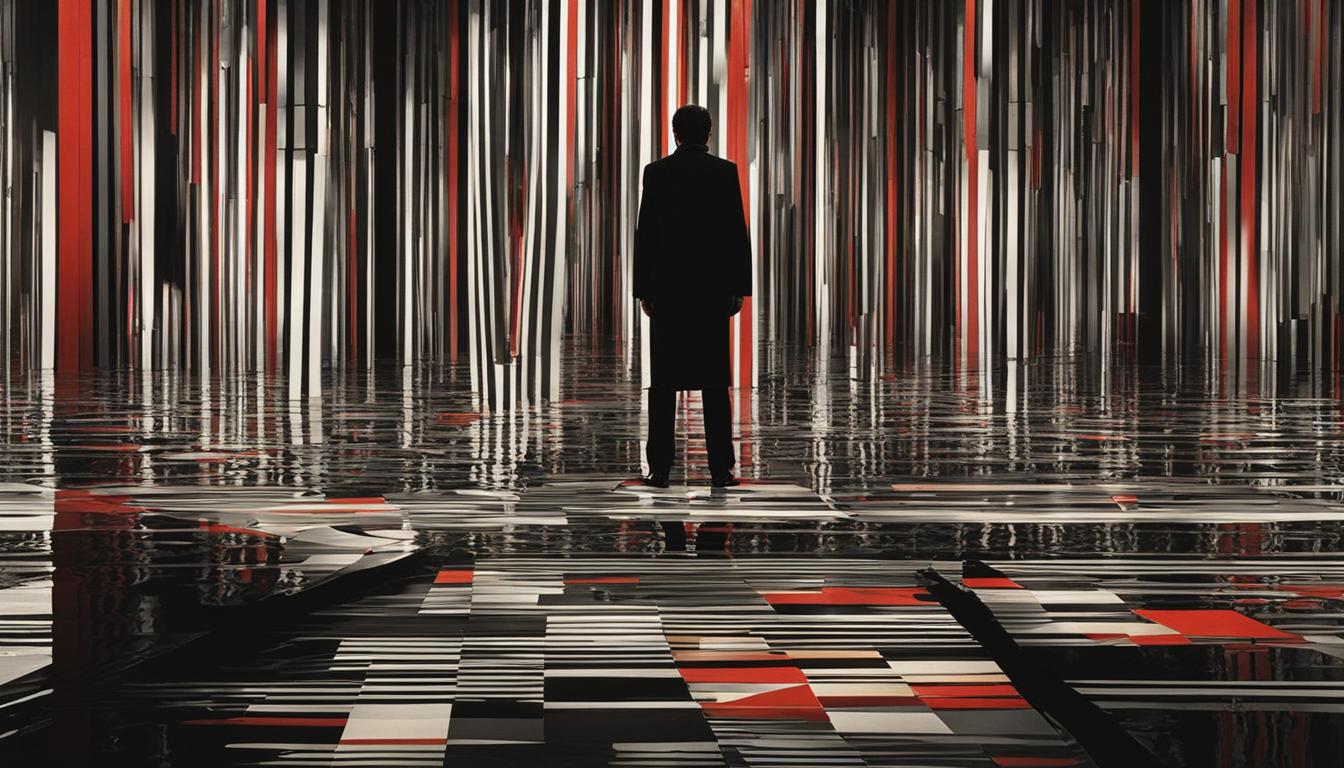“The Double” by José Saramago is a captivating novel that delves into the intriguing concept of identity and self. Written by the Nobel Prize-winning Portuguese author, this thought-provoking story follows the life of Tertuliano Máximo Afonso, a high school history teacher who becomes obsessed with his doppelgänger after seeing him in a movie. Published in 2002 as “O Homem Duplicado” in Portuguese and later translated into English as “The Double” in 2004, this book offers a compelling exploration of the complexities of human existence.
Throughout the novel, Saramago raises thought-provoking questions about personal identity, reality, and the consequences of obsession. With its unique style and engaging plot, “The Double” captivates readers and invites them to reflect on the blurred boundaries between illusion and truth.
Key Takeaways:
- “The Double” by José Saramago explores the concept of identity and self through the story of a history teacher obsessed with his doppelgänger.
- The novel raises thought-provoking questions about personal identity, the nature of reality, and the consequences of obsession.
- Written in a unique style characterized by long sentences and paragraphs, “The Double” offers a distinctive reading experience.
- The theme of duality and the exploration of contrasting elements are prevalent in literature, including Saramago’s novel.
- “The Double” has received mixed reviews from critics but has also been adapted into a film titled “Enemy,” starring Jake Gyllenhaal.
The Plot of “The Double”
The plot of “The Double” centers around Tertuliano Máximo Afonso, a history teacher who becomes fixated on finding his doppelgänger after seeing him in a movie. Tertuliano’s obsession with meeting the actor, António Claro, takes him on a journey of identity confusion and self-discovery.
As the story unfolds, Tertuliano’s relationship with his girlfriend, Maria da Paz, becomes strained, and he finds himself entangled in a complex web of deception and revenge. Through Tertuliano’s pursuit of his doppelgänger, the novel explores themes of personal identity, the nature of reality, and the consequences of obsession.
“The Double” by José Saramago is a captivating exploration of identity, duality, and the power of obsession.
Stay tuned for the next section where we delve into the significance of the double in literature.
The Significance of the Double in Literature
The theme of the double, also known as the doppelgänger, is a recurring motif in literature. It has captivated the minds of various authors throughout history, including influential figures like E.T.A. Hoffmann, Fyodor Dostoevsky, Edgar Allan Poe, and Oscar Wilde. The concept of the double represents the duality of human nature, the exploration of identity, and the idea that there are multiple versions of ourselves.
In literature, the idea of the double serves as a powerful literary theme that allows authors to delve into the complexities of human existence. Through the lens of the doppelgänger, writers can blur the boundaries between reality and illusion, presenting readers with thought-provoking narratives that challenge their perceptions of self and identity.
“The duality of the double not only reflects the internal conflicts within an individual but also highlights the contrasting aspects of human nature.”
The literary tradition of the double has provided fertile ground for authors to navigate profound philosophical questions about the nature of self and the intricacies of human behavior. By exploring the doppelgänger, these authors delve into the depths of human psychology and examine themes such as self-discovery, self-reflection, and the consequences of hidden desires.
“Literature allows us to examine the intricacies of our own identities, forcing us to question who we truly are, and whether our perception of self is accurate or merely an illusion.”
The doppelgänger serves as a vehicle through which authors can explore the untapped depths of the human psyche, challenging readers to confront their own fears, insecurities, and hidden desires. It provides a rich tapestry for storytelling, offering a unique lens through which to examine the complexities of the human experience.
Throughout the history of literature, the theme of the double has provided countless unforgettable characters and stories that continue to captivate readers. These narratives serve as mirrors to our own selves, inviting introspection and encouraging us to question the nature of our own identities.
Examples of the Double in Literature
Here are some notable examples of the double in literature:
- • “The Metamorphosis” by Franz Kafka: The protagonist, Gregor Samsa, wakes up one morning to find himself transformed into a giant insect, effectively becoming a double of his former self.
- • “Dr. Jekyll and Mr. Hyde” by Robert Louis Stevenson: Dr. Jekyll and Mr. Hyde symbolize the duality of human nature, with Jekyll representing the good side and Hyde representing the evil side.
- • “The Picture of Dorian Gray” by Oscar Wilde: The painting of Dorian Gray serves as his double, aging and decaying while he remains forever youthful and untouched.
| Author | Work | Description |
|---|---|---|
| E.T.A. Hoffmann | The Sandman | The protagonist, Nathanael, becomes consumed by his fear of a diabolical doppelgänger named Coppelius. |
| Fyodor Dostoevsky | The Double | The central character, Yakov Golyadkin, encounters his double, which leads to a series of psychological and existential crises. |
| Edgar Allan Poe | William Wilson | In this short story, the narrator encounters a mysterious double who seems to be an embodiment of his conscience. |
| Oscar Wilde | The Picture of Dorian Gray | The painting of Dorian Gray serves as his double, aging and decaying while he remains forever youthful and untouched. |
Incorporating the theme of the double, these authors have crafted compelling narratives that continue to resonate with readers across generations. Their works offer unique perspectives on the exploration of identity, the complexities of human existence, and the blurred boundaries between reality and illusion.

Critical Reception of “The Double”
The reception of José Saramago’s novel, “The Double,” has been met with a mixture of opinions from literary critics. Let’s take a look at what some reviewers had to say about this intriguing and thought-provoking book.
- Alberto Manguel, writing for The Guardian, expressed his belief that Saramago didn’t fully explore the concept of the double as much as he could have.
- Jonathan Carroll from The Washington Post criticized the novel for lacking emotional involvement, which he felt hindered the reader’s connection to the story.
- John Banville of The New York Times, on the other hand, praised Saramago’s cleverness and dark humor in crafting the novel. He drew comparisons between Saramago’s writing style and the works of literary giants such as Kafka, Celine, and Beckett.
John Banville in The New York Times praised the cleverness and dark humor of the novel, comparing Saramago’s writing to the works of Kafka, Celine, and Beckett.
It is evident that “The Double” has generated varied responses among critics, with some highlighting its strengths in terms of wit and wordplay, while others pinpointed areas that they felt could have been further explored or developed.
Furthermore, “The Double” has not only made an impact in the literary world but has also been adapted into a thrilling Canadian film titled “Enemy” in 2013. The film starred Jake Gyllenhaal in a dual role, adding another dimension to Saramago’s thought-provoking narrative.
| Reviewer | Publication | Review |
|---|---|---|
| Alberto Manguel | The Guardian | Believed that Saramago didn’t push the concept of the double far enough |
| Jonathan Carroll | The Washington Post | Negative criticism regarding the lack of emotional involvement |
| John Banville | The New York Times | Praised the cleverness and dark humor, praising Saramago’s writing style in comparison to Kafka, Celine, and Beckett |
Film Adaptation of “The Double”
“The Double” by José Saramago was brought to the big screen in a Canadian thriller film titled “Enemy” in 2013. Directed by Denis Villeneuve and featuring Jake Gyllenhaal in a dual role, the film adaptation captivated audiences with its atmospheric tension and Gyllenhaal’s mesmerizing performance. Set in Toronto, the story follows a man who stumbles upon his doppelgänger and becomes consumed by the mystery surrounding their connection.
The screenplay for “Enemy” was skillfully adapted by Javier Gullón from José Saramago’s original novel, capturing the essence of the thought-provoking story. The film received positive reviews for its ability to build intrigue and suspense, immersing viewers in the protagonist’s unsettling journey of self-discovery.
Unique Style of José Saramago
José Saramago, a renowned Portuguese author, is known for his distinctive writing style and narrative techniques that make his works stand out. His unique style, characterized by long sentences and paragraphs, the absence of quotation marks, and the blending of dialogue and narration, creates a mesmerizing reading experience for his audience. Saramago often employs the stream of consciousness technique, immersing readers in the inner thoughts and perspectives of his characters.
This stream of consciousness style allows for a deep exploration of the characters’ minds and emotions, providing readers with a profound understanding of their inner workings. Although Saramago’s writing style can be challenging at first, it rewards attentive readers with intricate layers of meaning and a profound connection to the characters.
Take a look at this quote from José Saramago’s novel “The Double“:
“The stream of consciousness, like José Saramago’s writing style, gracefully carries the reader through the labyrinthine maze of human thoughts and emotions, revealing the depth and complexity of the characters’ inner worlds.”
In his novel “The Double,” Saramago masterfully employs his unique style to capture the journey of Tertuliano Máximo Afonso and his obsession with finding his doppelgänger. Saramago’s narrative techniques, combined with his thought-provoking themes, create a literary experience that lingers in the reader’s mind long after the final page.
Image:
Themes Explored in “The Double”
“The Double” delves into several compelling themes that resonate throughout the novel, highlighting the complex nature of human existence. One of the central themes that unfolds is the quest for personal identity and the profound confusion that arises when faced with a doppelgänger. Tertuliano Máximo Afonso’s relentless pursuit to find his identical counterpart forces him to question his own sense of self and grapple with the mysterious nature of identity.
Furthermore, the novel delves into the destructive power of obsession and the far-reaching consequences it can have on both individuals and their relationships. Tertuliano’s unwavering fixation on his doppelgänger not only disrupts his personal life but also leads him down a dark path of self-deception and blurred realities, blurring the lines between obsession and sanity.
Deception and revenge also play prominent roles in the story, adding layers of intrigue and complexity. As the plot unfolds, deception becomes a prevalent theme, as characters manipulate and deceive one another, blurring the boundaries of truth and falsehood. The concept of revenge further amplifies the narrative, showcasing the lengths to which individuals may go when their sense of self is threatened or compromised.
Overall, “The Double” masterfully explores themes of identity, obsession, deception, and revenge, unraveling a thought-provoking tale that captivates readers and invites introspection into the depths of the human psyche.

| Themes | Examples |
|---|---|
| Identity | The confusion and search for personal identity when faced with a doppelgänger |
| Obsession | The destructive power of obsession and its impact on relationships |
| Deception | The manipulation of truth and the blurred boundaries between reality and illusion |
| Revenge | The consequences and motivations behind acts of revenge |
The Fascination with Duality in Literature
The exploration of duality in literature extends beyond just the concept of the double. Countless authors have delved into the theme of duality to illuminate the complexities of human nature and the contrasting elements that reside within each of us. From Robert Louis Stevenson’s “Strange Case of Dr. Jekyll and Mr. Hyde” to Joseph Conrad’s “The Secret Sharer,” literature has utilized the notion of duality as a powerful vehicle for delving into the darker aspects of human existence and the internal conflicts we face.
Through the exploration of these contrasting elements, literature provides us with a deeper understanding of the human experience. It allows us to confront the conflicting desires, motivations, and choices that shape our identities. By exposing the dual nature that exists within us, literature serves as a mirror, reflecting the complexities and contradictions inherent in the human condition.
“Man is not truly one, but truly two.”
– Robert Louis Stevenson, “Strange Case of Dr. Jekyll and Mr. Hyde”
In literature, duality can take various forms. It can manifest through opposing characters, such as the virtuous Dr. Jekyll and the sinister Mr. Hyde. It can also be explored through the interplay of light and darkness, good and evil, or sanity and madness. These contrasting elements create tension, driving the narrative forward and challenging readers to contemplate the multifaceted nature of humanity.
Examples of Duality in Literature
| Book Title | Author | Duality Explored |
|---|---|---|
| “Strange Case of Dr. Jekyll and Mr. Hyde” | Robert Louis Stevenson | The duality of good and evil within a single individual |
| “The Picture of Dorian Gray” | Oscar Wilde | The conflict between the physical and moral aspects of a character |
| “Heart of Darkness” | Joseph Conrad | The exploration of civilization and savagery |
| “The Strange and Mr. Norrell” | Susanna Clarke | The tension between magic and reason |
These examples highlight how duality serves as a powerful tool for authors to delve into the depths of human nature. By juxtaposing contrasting elements, writers encourage readers to contemplate their own inner conflicts and confront the shades of gray that exist within themselves.
The fascination with duality in literature is rooted in our innate desire to understand the complexities of the human experience. Through the exploration of contrasting elements, authors provide profound insights into the human psyche, ultimately inviting readers to embark on a journey of self-discovery and introspection.
Conclusion
“The Double” by José Saramago is a thought-provoking novel that delves into the fascinating themes of identity, duality, and the power of obsession. Through the captivating narrative of Tertuliano Máximo Afonso’s search for his doppelgänger, Saramago takes readers on a journey into the depths of the human psyche. This book offers a unique exploration of the complexities of self-discovery and raises poignant questions about the nature of identity.
Saramago’s powerful storytelling is complemented by his unique writing style. With long, flowing sentences and the absence of quotation marks, the author skillfully immerses readers in the minds and emotions of the characters. This narrative technique creates a profound reading experience, allowing for a deeper understanding of the internal struggles and conflicts faced by the characters.
For fans of literary fiction and those intrigued by the theme of the double in literature, “The Double” is a must-read. It challenges conventional notions of self and reality, offering a fresh perspective on the human condition. José Saramago’s exploration of doppelgängers and the inherent desire to unravel the mysteries of our own identities will leave readers pondering the intricate connections between perception and truth.



